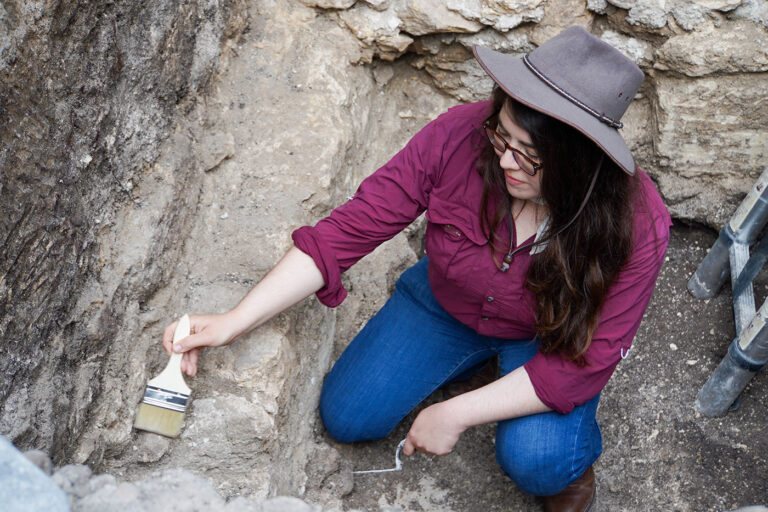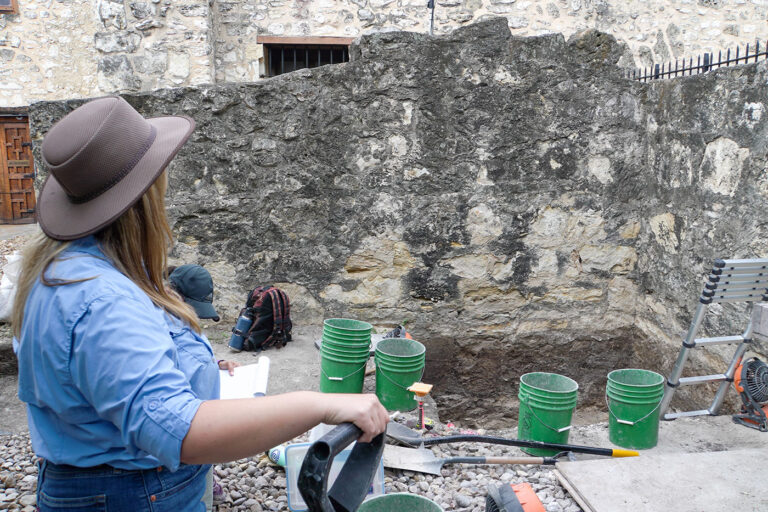When Tiffany Lindley, PhD ’20, first came to UT San Antonio, the city was unfamiliar territory and the university itself was a complete unknown. Drawn solely by the chance to work under faculty and archaeologists Jason Yaeger and Kat Brown, Lindley now views this decision as pivotal in shaping her career.
“I knew nothing about San Antonio or UTSA,” Lindley recalls, “but I dare say it was one of the best decisions I made because it really helped me get to where I am today.”
Today, Lindley serves as the director of archaeology at The Alamo, a role where she oversees significant excavation projects that help rewrite and enhance the narrative of Texas history.
Lindley heads major archaeological efforts, notably the Long Barrack Drainage Project and the ongoing excavation around the Alamo Church. The Long Barrack project recently unearthed approximately 250,000 artifacts, items untouched since the 1700s, a remarkable achievement in an area as thoroughly developed as downtown San Antonio. These efforts are part of a $550 million comprehensive project to reclaim the battle site from urban growth. The efforts also include a world-class Alamo Visitor Center and Museum and the Texas Cavaliers Education Center.
“It’s amazing how much history is still buried just below our feet,” Lindley says. “We are literally uncovering tangible evidence of past lives every day.”
Lindley has also built a strong team at The Alamo, hiring fellow UT San Antonio anthropology graduates Gabriella Zaragosa and Kat Jenkins ’20, whom she praises for their problem-solving abilities and hands-on expertise. Zaragoza’s knowledge of communal spaces and plazas has proven insightful in Alamo Plaza projects, while Jenkins’ mastery of archaeological lab work makes her invaluable in processing and identifying artifacts.


“Gabriella and Kat brought exceptional critical thinking skills from UTSA,” Lindley says. “Their skills were sharp coming in, and UTSA’s influence is clearly visible in their approach to archaeology.”
UT San Antonio’s Anthropology program, renowned for its four-field approach, laid the foundation for the trio’s current roles at The Alamo. The program emphasized collaboration across various disciplines, a skill Lindley finds invaluable in her work at the Alamo.
Lindley’s most influential experiences at UT San Antonio involved working closely with her mentors, Yaeger and Brown, particularly on their projects in Belize. From them, she learned the importance of building and maintaining strong professional relationships.
“The UTSA Anthropology program really stressed the importance of collaboration with professionals in other fields,” Lindley says. “Now, I regularly work on multidisciplinary projects alongside engineers, historians and geologists. Jason and Kat were always big on making sure we built relationships and didn’t stay isolated in our academic bubbles.”
Lindley’s passion for archaeology extends beyond excavation. She champions public outreach through social media and an Alamo internship program, actively working to inspire the next generation of archaeologists.
“Interacting with students and the public, showing them archaeology is a real job and a career, is incredibly rewarding,” says Lindley, who had the following advice for aspiring anthropology and archaeology students. “Talk to people who have the jobs you want, step outside your comfort zone and never shy away from new opportunities. There is so much out there to still be discovered.”
WATCH: Learn what happens to the artifacts found at The Alamo.
Ultimately, Lindley emphasizes archaeology’s role in understanding everyday lives throughout history and the complex communities they developed around them.
“It’s the everyday people that make the world go round,” Lindley says. “They are the real heroes of history, and that’s what makes archaeology at a place like The Alamo so meaningful.”



No comment yet, add your voice below!